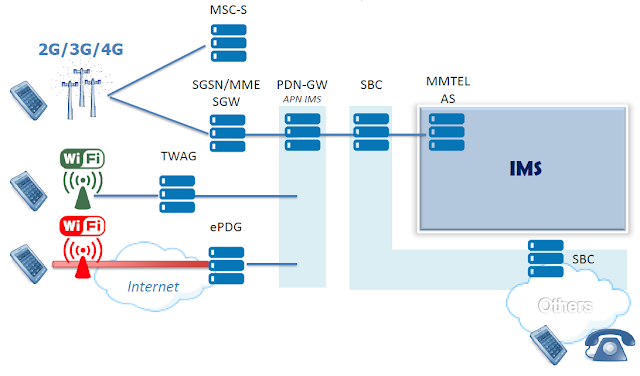What is VoLTE and VoWiFi ?

Voice over Long-Term Evolution (VoLTE) is a standard high-speed wireless communication for mobile phones and data terminals. It is based on the IP Multimedia Subsystem (IMS) network, with specific profiles for control and media planes of voice service on the LTE wireless broadband service defined by GSMA. This approach results in the voice service (control and media planes) being delivered as data flows within the LTE data bearer, with no dependency on (or ultimately, requirement for) the circuit-switched voice network to be in the call path. VoLTE has up to three times more voice and data capacity than older 3G UMTS and up to six times more than 2G GSM. To be able to make a VoLTE call the device, its firmware, and the mobile telephony provider must all support the service in the area, and be able to work together.

What is the value of VoWiFi?
Consumers:
- Can make calls without the need for a mobile signal (e.g. in a remote location or from within a property with thick walls
- Benefit from security based on SIM-based authentication as for VoLTE
- Experience better indoor coverage
- Strong network security from a trusted operator that protects data from unlawful intercept and hacking.
- Voice and video calling everywhere with service bundles that can lower rates and reduce roaming fees.
Operators:
- Unlock revenue opportunities
- Leverage existing SIM-based security and authentication as for VoLTE
- Gain the opportunity to access IMS-based services via Wi-Fi access
- Issue a single bill for the user for all IMS-based services across different access types
- Gain a competitive advantage
- Benefit from voice/video telephony services provided by IMS and the MMTEL application server as for VoLTE/ViLTE.
Challenges of adding Wi-Fi to LTE networks:
There are two main challenges:
- Service continuity: Mobile device IP addresses must be preserved when moving between LTE and Wi-Fi, to ensure seamless handovers of calls and other network services such as enterprise VPNs.
- Service consistency/security: Public Wi-Fi networks are susceptible to hacking. Secure tunneling protocols and subscriber authentication methods are required.
EPC Architecture for LTE with WIFI access:
 |
| WIFI and LTE EPC Architecture |
In the standards, Wi-Fi is considered a type of non-3GPP wireless access, which the MNO can view as either a trusted network or an untrusted network.To support these two network access types, two core network functions are needed:
- Evolved Packet Data Gateway (ePDG): Supports the untrusted non-3GPP Wi-Fi access network
- Trusted Wireless Access Gateway (TWAG): Supports the trusted non-3GPP Wi-Fi access network
- Secure tunneling and aggregation of traffic from Wi-Fi access points (APs).
- Interface to the AAA server for authentication of the mobile device to the EPC.
- Access to the EPC via secure tunneling mechanisms (GTP or PMIP) to the MNO’s packet gateway (PGW) which provides the IP address for the mobile device.
- Create the session request for bearer establishment and do the VoWiFi call data forwarding between the Wi-Fi access network and MNO’s PGW.
Read also:
Subscribe by Email
Follow Updates Articles from This Blog via Email




No Comments